With the season advancing rapidly and the honeyflow in most of the country about to begin, I would appreciate some pointers about handling beeswax.
Beeswax is not produced in such large quantities as honey, but because of the higher market price it demands, it does deserve special attention. This refers not only to the methods used in melting down cappings and comb and preparing the cleaned cakes for market, but also to efforts at salvaging all wax possible.
Although no one would consider throwing away his cappings, it is surprising that so many overlook a less obvious but significant source of wax. This secondary wax source is the wax in burr comb, volunteer comb and other bits and pieces of wax that so often are left lying beside the hive and ultimately lost. It is quite surprising how quickly these little bits and pieces can accumulate. We are pleasantly reminded of this each year here in the breeding lab, as the small cakes of relatively clean light wax come in from the little solar wax melter. The fellows working the outyards save all scrapings and comb, then dump them into the solar extractor when they return to the lab. The same is true of the wax from the little four-frame nuclei located here at the home yard. Because many of the nucs are run one comb short to more easily facilitate queen spotting and reduce possibilities of queen damage when removing that first comb, we often find nice chunks of volunteer comb. Those that contain honey are laid in front of the nuc (if the robbing season isn’t upon us) and when dry, they are also melted up.
The solar extractor mentioned above is an ideal way to handle wax melting, as it keeps wax rendered out as the season progresses. This eliminates the wax refuse accumulation that invites wax moth problems. The solar extractors are also inexpensive. Varying sizes can be purchased ready built, or they can be built simply and easily at home. One other advantage of the solar melter not mentioned so far is the lightening effect produced by gentle sun bleaching.
For small amounts of cappings, the solar melter will also do the job. The cappings may either be washed first to remove the honey adhering or the wet cappings can be placed directly in the melter. When this is done, there will be a layer of honey beneath the wax in the collecting pan. This honey may be slightly darkened, but can be readily fed back to your bees. The wax layer on top can then be washed and is ready for sale.
If a solar melter is not used and size of operation does not justify one of the several cappings melters on the market, small amounts of cappings can be melted in the kitchen, providing you have an understanding wife. However, wax is flammable, so direct heat under the wax should be applied only with extreme care. Direct heat will also tend to darken both wax and honey. Best results will be obtained if a double boiler approach is used.
After gentle heating, the liquid wax can be skimmed from the top and poured into suitable molds, or else the entire container can be allowed to cool. After the wax cake on top is solid, it can be removed, washed, and the bottom of the cake can then be scraped clean.
If the cappings have been washed before melting, and there is no honey to salvage, the cappings can best be melted with water added to the container. This reduces the likelihood of overheating and darkening the wax. However, avoid over-boiling, as “spongy” wax (water-soaked) will likely be obtained. If this should happen, the “spongy” wax can be reclaimed by gently melting without water.
Any container that comes in contact with hot wax must be carefully selected. Stainless steel is excellent, but may not be readily available. Aluminum is also good, as are enamelware and tin or tin-coated ones. Metals such as copper and brass, which give beeswax a greenish color, and monel metal, iron, and zinc, which impart a gray cast, should be avoided.
Because beeswax contracts as it solidifies, removal from molds is usually not a problem. However, if the wax is poured into the mold too hot or is allowed to solidify too quickly, it is apt to crack in the center and then adhere to the sides of the mold. Best results will be obtained by pouring when the wax is just over the solidifying point and then covering the mold with a board or cardboard. This allows slow cooling, and the wax will contract away from the sides of the mold to form a uniform, solid cake. One other pan release aid can be used. A small amount of hot water can be placed in the bottom of the mold. The wax will solidify on top of the water so there will be no contact with the bottom of the mold.
Rendering wax from slum or old combs requires additional steps and special equipment to press the sacks of material which are kept under water, and the resulting wax will not be as light in color. Old combs and slum contain propolis, pollen grains and coloring matter from pollen, and cast-off pupal cases. The wax picks up color from these materials, and it is very difficult to remove without resorting to bleaching techniques impractical on a small scale at home.
In addition to the color problem, the foreign matter present in slum and old combs gives up the wax with which it is saturated very reluctantly. The simplest way of removing the wax involves both water and pressure. By first soaking these materials in water before rendering, they appear less capable of absorbing wax during processing. The water soaked slum material should then be repeatedly squeezed under very hot water to press out as much of the wax as possible. By doing the squeezing under hot water, the melted wax that is released floats to the top of the container and can be skimmed off.
Although no one would consider throwing away his cappings, it is surprising that so many overlook a less obvious but significant source of wax. This secondary wax source is the wax in burr comb, volunteer comb and other bits and pieces of wax that so often are left lying beside the hive and ultimately lost. It is quite surprising how quickly these little bits and pieces can accumulate. We are pleasantly reminded of this each year here in the breeding lab, as the small cakes of relatively clean light wax come in from the little solar wax melter. The fellows working the outyards save all scrapings and comb, then dump them into the solar extractor when they return to the lab. The same is true of the wax from the little four-frame nuclei located here at the home yard. Because many of the nucs are run one comb short to more easily facilitate queen spotting and reduce possibilities of queen damage when removing that first comb, we often find nice chunks of volunteer comb. Those that contain honey are laid in front of the nuc (if the robbing season isn’t upon us) and when dry, they are also melted up.
The solar extractor mentioned above is an ideal way to handle wax melting, as it keeps wax rendered out as the season progresses. This eliminates the wax refuse accumulation that invites wax moth problems. The solar extractors are also inexpensive. Varying sizes can be purchased ready built, or they can be built simply and easily at home. One other advantage of the solar melter not mentioned so far is the lightening effect produced by gentle sun bleaching.
For small amounts of cappings, the solar melter will also do the job. The cappings may either be washed first to remove the honey adhering or the wet cappings can be placed directly in the melter. When this is done, there will be a layer of honey beneath the wax in the collecting pan. This honey may be slightly darkened, but can be readily fed back to your bees. The wax layer on top can then be washed and is ready for sale.
If a solar melter is not used and size of operation does not justify one of the several cappings melters on the market, small amounts of cappings can be melted in the kitchen, providing you have an understanding wife. However, wax is flammable, so direct heat under the wax should be applied only with extreme care. Direct heat will also tend to darken both wax and honey. Best results will be obtained if a double boiler approach is used.
After gentle heating, the liquid wax can be skimmed from the top and poured into suitable molds, or else the entire container can be allowed to cool. After the wax cake on top is solid, it can be removed, washed, and the bottom of the cake can then be scraped clean.
If the cappings have been washed before melting, and there is no honey to salvage, the cappings can best be melted with water added to the container. This reduces the likelihood of overheating and darkening the wax. However, avoid over-boiling, as “spongy” wax (water-soaked) will likely be obtained. If this should happen, the “spongy” wax can be reclaimed by gently melting without water.
Any container that comes in contact with hot wax must be carefully selected. Stainless steel is excellent, but may not be readily available. Aluminum is also good, as are enamelware and tin or tin-coated ones. Metals such as copper and brass, which give beeswax a greenish color, and monel metal, iron, and zinc, which impart a gray cast, should be avoided.
Because beeswax contracts as it solidifies, removal from molds is usually not a problem. However, if the wax is poured into the mold too hot or is allowed to solidify too quickly, it is apt to crack in the center and then adhere to the sides of the mold. Best results will be obtained by pouring when the wax is just over the solidifying point and then covering the mold with a board or cardboard. This allows slow cooling, and the wax will contract away from the sides of the mold to form a uniform, solid cake. One other pan release aid can be used. A small amount of hot water can be placed in the bottom of the mold. The wax will solidify on top of the water so there will be no contact with the bottom of the mold.
Rendering wax from slum or old combs requires additional steps and special equipment to press the sacks of material which are kept under water, and the resulting wax will not be as light in color. Old combs and slum contain propolis, pollen grains and coloring matter from pollen, and cast-off pupal cases. The wax picks up color from these materials, and it is very difficult to remove without resorting to bleaching techniques impractical on a small scale at home.
In addition to the color problem, the foreign matter present in slum and old combs gives up the wax with which it is saturated very reluctantly. The simplest way of removing the wax involves both water and pressure. By first soaking these materials in water before rendering, they appear less capable of absorbing wax during processing. The water soaked slum material should then be repeatedly squeezed under very hot water to press out as much of the wax as possible. By doing the squeezing under hot water, the melted wax that is released floats to the top of the container and can be skimmed off.


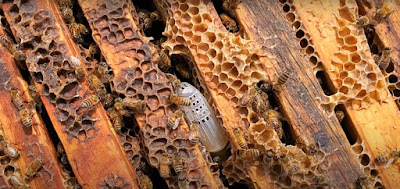
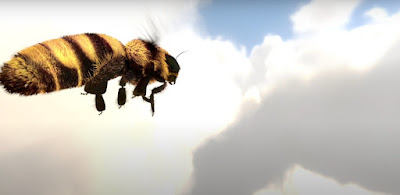

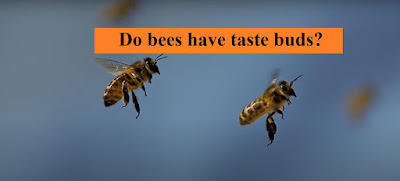
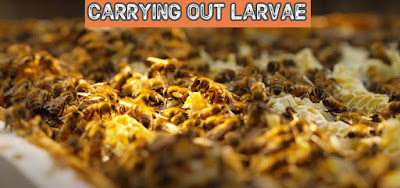
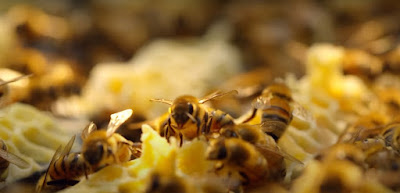

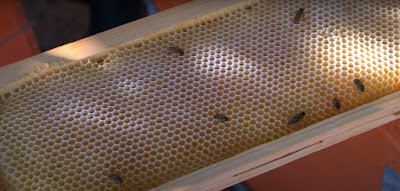


Comments
Post a Comment